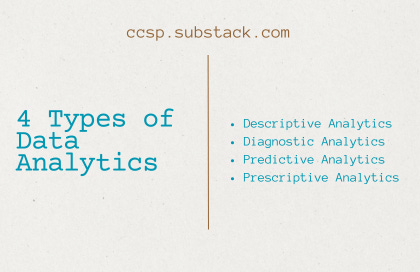CCSP: Emerging Technologies: 4 Types of Data Analytics
Descriptive Analytics, Diagnostic Analytics, Predictive Analytics, Prescriptive Analytics
Data analytics versus data analysis
Data analytics is the process of using specialised tools and techniques to find value from raw data.
Data analysis is the practice of interpreting data that leads to meaningful decisions.
Why is data analytics important?
Data analytics helps companies gain more visibility and a deeper understanding of their processes and services.
It gives companies detailed insights into the customer experience and customer problems.
By shifting the paradigm beyond data to connect insights with action, companies can
Create personalised customer experiences
Build related digital products
Optimise operations
Increase employee productivity
Analytics types and techniques
There are four types of data analytics, each serving different purposes and using different techniques.
Descriptive analytics
Descriptive analytics helps to answer what happened. It uses several visualisation techniques, including
Pie charts
Bar charts
Line graphs
Tables
Generated narratives
Pie charts - Diagrams that show data as slices in a circular-shaped graph.
Bar charts - Diagrams that show data in rectangular bars, horizontally or vertically.
Line graphs - Diagrams that use lines to connect single data points generally plotted over a period of time.
Tables - Diagrams that show data in rows and columns.
Generative narratives - You ask questions about your data and receive answers with visualisations.
Diagnostic analytics
Diagnostic analytics helps to answer why it happened. It uses several techniques, such as:
Drill-down: Seeing an overview of the data, to a detailed view within the same dataset.
Data discovery: The process of gathering, cataloging, and classifying data from different databases for analytics.
Data mining: Using analytics against a large dataset to discover meaningful insights.
Correlations: A measure between two variables that shows how closely-related they are without stating a cause-and-effect relationship.
Predictive analytics
Predictive analytics helps answer what might happen in the future. It uses techniques such as
Machine learning (ML): A technique that teaches software how to
Learn from data
Find patterns
Make decisions with minimal human intervention
Forecasting: Predicting the future value by looking at unique trends.
Pattern matching: Finding pre-determined patterns in raw data.
Predictive modelling: Predicting future events by analysing patterns with input data.
Prescriptive analytics
Prescriptive analytics recommends actions to the predicted outcome. It uses techniques, such as:
Graph analysis: Analysing relationships between objects in a network or graph.
Simulation: Modelling the behaviour of a system by using the characteristics and relationships of system components.
Complex event processing: Deriving a conclusion through tracking and analysing streaming data.
Neural networks: A machine learning model inspired by the human brain, capable of learning and solving complex problems.
Recommendation engines: A system that uses ML to recommend the most relevant items to a user, based on behaviour patterns.












